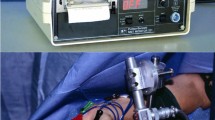Abstract
Intense neuromuscular blockade (NMB) measured by post tetanic count (PTC) was monitored, reversed and verified in this pig model. In a cross-over assessor blinded design six pigs were randomized to either no NMB followed by intense NMB, or intense NMB followed by no NMB. Neuromuscular measurements were performed with acceleromyography [train-of-four (TOF) Watch SX]. In all pigs, the response to TOF nerve stimulation was stable and intense NMB (PTC 0–1) was established with rocuronium 3 mg/kg. For reversal, the pigs received sugammadex 20–35 mg/kg and returned to TOF-ratio above 0.90 within 2.15 min after injection. We established a pig model for monitoring intense NMB with surface stimulation electrodes and acceleromyography. We verified total relaxation of the diaphragm and the abdominal muscles at the PTC 0–1 by suction test and with surface electromyography. This pig model is suitable for studies with experimental abdominal surgery with monitoring of intense NMB, and where relaxation of the diaphragm and the abdominal muscles are required.


Similar content being viewed by others
References
King M, Sujirattanawimol N, Danielson DR, Hall BA, Schroeder DR, Warner DO. Requirements for muscle relaxants during radical retropubic prostatectomy. Anesthesiology. 2000;93:1392–7.
Brull SJ, Murphy GS. Residual neuromuscular block: lessons unlearned. Part II: methods to reduce the risk of residual weakness. Anesth Analg. 2010;111:129–40.
Fernando PU, Viby-Mogensen J, Bonsu AK, Tamilarasan A, Muchhal KK, Lambourne A. Relationship between posttetanic count and response to carinal stimulation during vecuronium-induced neuromuscular blockade. Acta Anaesthesiol Scand. 1987;31:593–6.
Dhonneur G, Kirov K, Motamed C, et al. Post-tetanic count at adductor pollicis is a better indicator of early diaphragmatic recovery than train-of-four count at corrugator supercilii. Br J Anaesth. 2007;99:376–9.
Pittet JF, Morel DR, Mentha G, et al. Vecuronium neuromuscular blockade reflects liver function during hepatic autotransplantation in pigs. Anesthesiology. 1994;81:168–75.
Veres-Nyeki KO, Rieben R, Spadavecchia C, Bergadano A. Pancuronium dose refinement in experimental pigs used in cardiovascular research. Vet Anaesth Analg. 2012;39:529–32.
Fuchs-Buder T, Claudius C, Skovgaard LT, Eriksson LI, Mirakhur RK, Viby-Mogensen J. Good clinical research practice in pharmacodynamic studies of neuromuscular blocking agents II: the Stockholm revision. Acta Anaesthesiol Scand. 2007;51:789–808.
Viby-Mogensen J, Howardy-Hansen P, Chraemmer-Jorgensen B, Ording H, Engbaek J, Nielsen A. Posttetanic count (PTC): a new method of evaluating an intense nondepolarizing neuromuscular blockade. Anesthesiology. 1981;55:458–61.
Alderson B, Senior JM, Jones RS, Dugdale AH. Use of rocuronium administered by continuous infusion in dogs. Vet Anaesth Analg. 2007;34:251–6.
Martin-Flores M, Gleed RD, Basher KL, Scarlett JM, Campoy L, Kopman AF. TOF-Watch(R) monitor: failure to calculate the train-of-four ratio in the absence of baseline calibration in anaesthetized dogs. Br J Anaesth. 2012;108:240–4.
Sarrafzadeh-Rezaei F, Eddie CR. The post-tetanic count during vecuronium-induced neuromuscular blockade in halothane-anaesthetized dogs. Vet Anaesth Analg. 2009;36:246–54.
Kirov K, Motamed C, Ndoko SK, Dhonneur G. TOF count at corrugator supercilii reflects abdominal muscles relaxation better than at adductor pollicis. Br J Anaesth. 2007;98:611–4.
Claudius C, Viby-Mogensen J. Acceleromyography for use in scientific and clinical practice: a systematic review of the evidence. Anesthesiology. 2008;108:1117–40.
Herweling A, Latorre F, Herwig A, Horstick G, Kempski O, Gervais HW. The hemodynamic effects of ephedrine on the onset time of rocuronium in pigs. Anesth.Analg. 2004; 99: 1703–7, table.
Pape A, Kertscho H, Stein P, et al. Neuromuscular blockade with rocuronium bromide increases the tolerance of acute normovolemic anemia in anesthetized pigs. Eur Surg Res. 2012;48:16–25.
Conflict of interest
This study was supported in part by a Research Grant from the Merck Investigator Initiated Studies Program. The opinions expressed in this paper are those of the authors and do not necessarily represent those of Merck. Jacob Rosenberg and Mona Ring Gätke have received payments for lectures and travel funding from Merck.
Ethical standard
The Animal Experiments Inspectorate approved the study.
Author information
Authors and Affiliations
Corresponding author
Rights and permissions
About this article
Cite this article
Madsen, M.V., Donatsky, A.M., Jensen, B.R. et al. Monitoring of intense neuromuscular blockade in a pig model. J Clin Monit Comput 28, 351–355 (2014). https://doi.org/10.1007/s10877-013-9539-1
Received:
Accepted:
Published:
Issue Date:
DOI: https://doi.org/10.1007/s10877-013-9539-1




